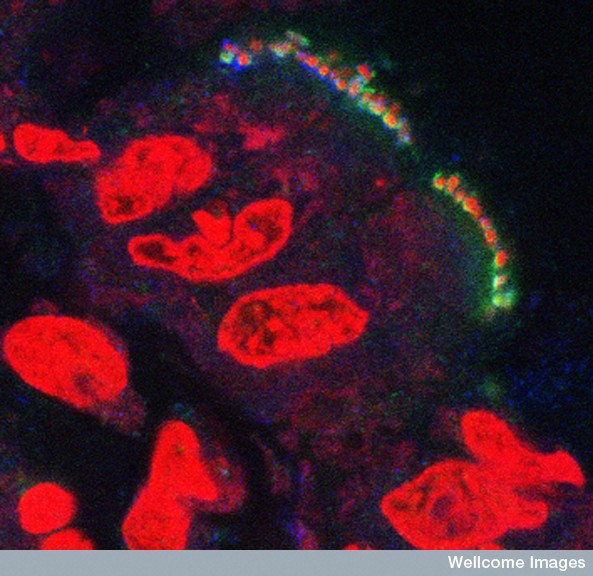A sh*tload of data
There are more microbial cells in our body than our own. Those microbes are not just passive hitchhikers or conversely, malicious agents of disease. They affect our well-being and health in a much broader spectrum than simply “bad” or “passive”. Among other things our gut microbes play an important role in digestion, have been linked to obesity, conditions as severe as certain inflammatory bowel syndromes or as relatively mild as traveler’s diarrhea. The microbes living on our skin also affect many things: from body odor and dandruff and acne to dermatitis and psoriasis. Also, being the most exposed microbial population means that they are themselves affected by our constant exposure to various agents,and their population varies by our own behavior — such as how often, and with what, do we wash our hands: antibacterial soap has been named as a major culprit in the development of resistant bacterial strains. In all organs the native flora, relatively benign, protects us against colonization by more virulent bacteria.
Indeed, our gut, skin, mouth and genital microbiomes can be viewed as additional organs in the way that they affect us. If you take a long course of powerful systemic antibiotics, the ensuing diarrhea and sometimes mouth thrush are the result of these “organs” — in your mouth and gut — being removed temporarily from your body.
Today, another big step has been taken towards understanding the role of our microbiomes play. Just how big, in what direction, or what will be the consequences of this step is unclear, and will remain unclear for quite some time. A group of Chinese and European researchers have published the largest sequencing effort yet of gut bacteria. Their current yield, 576 Gigabases of DNA from the feces of 124 European people is considerably larger than the previous large effort in the US: 3GB from sequenced from 33 US and Japanese adults. Also, Qin and colleagues looked at obese, lean, healthy and sick (inflamatory bowel syndrome) individuals. They identified 1,000 to 1,100 different bacterial species, with about 160 different species per individual. Healthy individual’s bacterial population was markedly different that those with inflammatory bowel syndromes, and the populations of those with IBS differed depending on disease type.
What does this all mean? Well, like in the human genome project, it will take a while before we understand not only what these data contain, but what are the limits of our ability to interpret them, and how best they can serve us. What we have right now is the equivalent of the outline of a newly discovered continent. It is up to many individual explorers to discover and chart the myriad living things in terra excreta. Which genes are most associated with obesity or with ulcerative colitis? How prevalent is gene transfer between gut bacteria, and how much of a role does this play in antibiotic resistance? Are there microbial species more prone to changes in their genomes than others? Are there metabolic pathways that are shared between different microbial species? Are some genes faster evolving than others, what would be the ecological role different species play in the gut? And how do different microbial populations ultimately affect their human hosts? Do different bacterial species have a preference with whom they share our guts? These broad questions can be broken down into individual questions relating to a lab’s pet genes, metabolic pathways, microbial species and metabolic conditions. There is a lot to sift through here and these data will keep us busy for years to come.
In other blogs Carl Zimmer has a great post on how he, for one welcomes our bacterial overlords, while Ed Yong talks about the science of things to come.
Oh, and for those of you who, like me, can’t wait to plug the data into your favorite analysis pipeline, you can get the gene and assembled and annotated sequence data data from Peer Bork’s lab at the European Molecular Biology Laboratory, or the Beijing Genome Institute. The raw sequence data are available from the European Bioinformatics Institute under the accession ERA000116. (I can’t find the latter myself right now, hopefully they will show up in a couple of days). Update March 7, 2010: the sequences are now deposited at EBI. Also, on BioTorrents (hat tip to Morgan Langille).
Qin, J., Li, R., Raes, J., Arumugam, M., Burgdorf, K., Manichanh, C., Nielsen, T., Pons, N., Levenez, F., Yamada, T., Mende, D., Li, J., Xu, J., Li, S., Li, D., Cao, J., Wang, B., Liang, H., Zheng, H., Xie, Y., Tap, J., Lepage, P., Bertalan, M., Batto, J., Hansen, T., Le Paslier, D., Linneberg, A., Nielsen, H., Pelletier, E., Renault, P., Sicheritz-Ponten, T., Turner, K., Zhu, H., Yu, C., Li, S., Jian, M., Zhou, Y., Li, Y., Zhang, X., Li, S., Qin, N., Yang, H., Wang, J., Brunak, S., Doré, J., Guarner, F., Kristiansen, K., Pedersen, O., Parkhill, J., Weissenbach, J., Antolin, M., Artiguenave, F., Blottiere, H., Borruel, N., Bruls, T., Casellas, F., Chervaux, C., Cultrone, A., Delorme, C., Denariaz, G., Dervyn, R., Forte, M., Friss, C., van de Guchte, M., Guedon, E., Haimet, F., Jamet, A., Juste, C., Kaci, G., Kleerebezem, M., Knol, J., Kristensen, M., Layec, S., Le Roux, K., Leclerc, M., Maguin, E., Melo Minardi, R., Oozeer, R., Rescigno, M., Sanchez, N., Tims, S., Torrejon, T., Varela, E., de Vos, W., Winogradsky, Y., Zoetendal, E., Bork, P., Ehrlich, S., & Wang, J. (2010). A human gut microbial gene catalogue established by metagenomic sequencing Nature, 464 (7285), 59-65 DOI: 10.1038/nature08821





















The data is also available via BioTorrents:
http://www.biotorrents.net/details.php?id=48